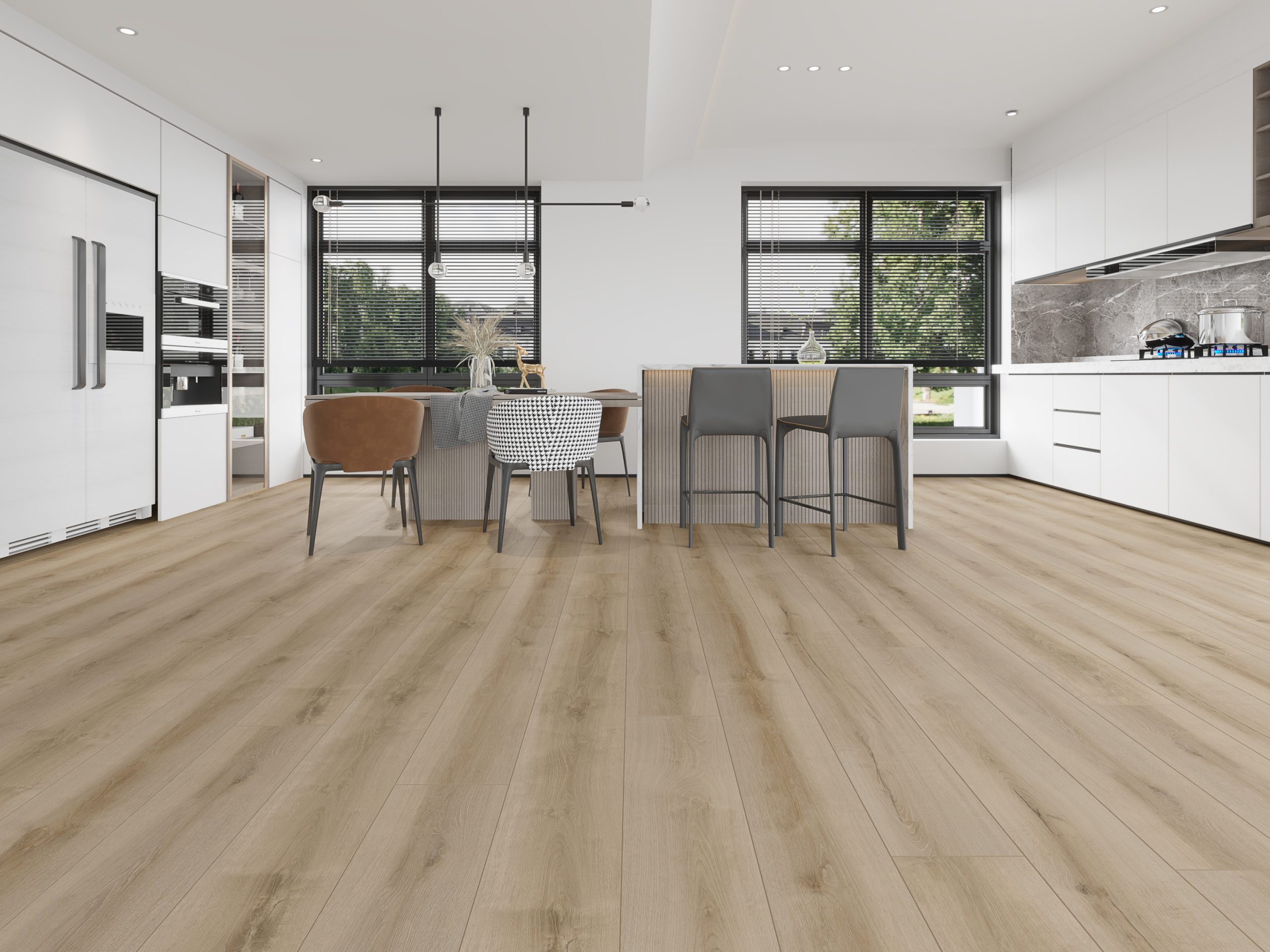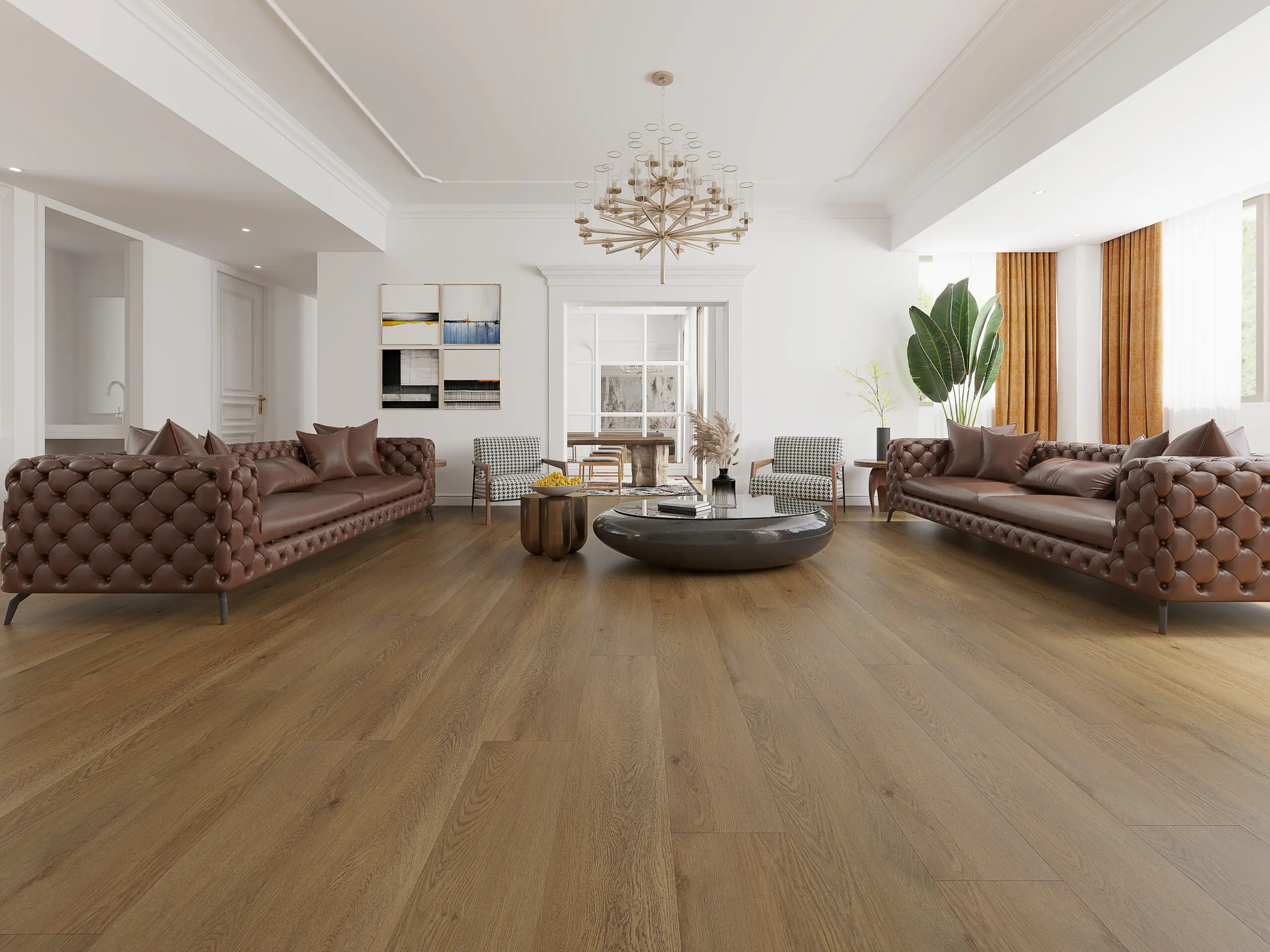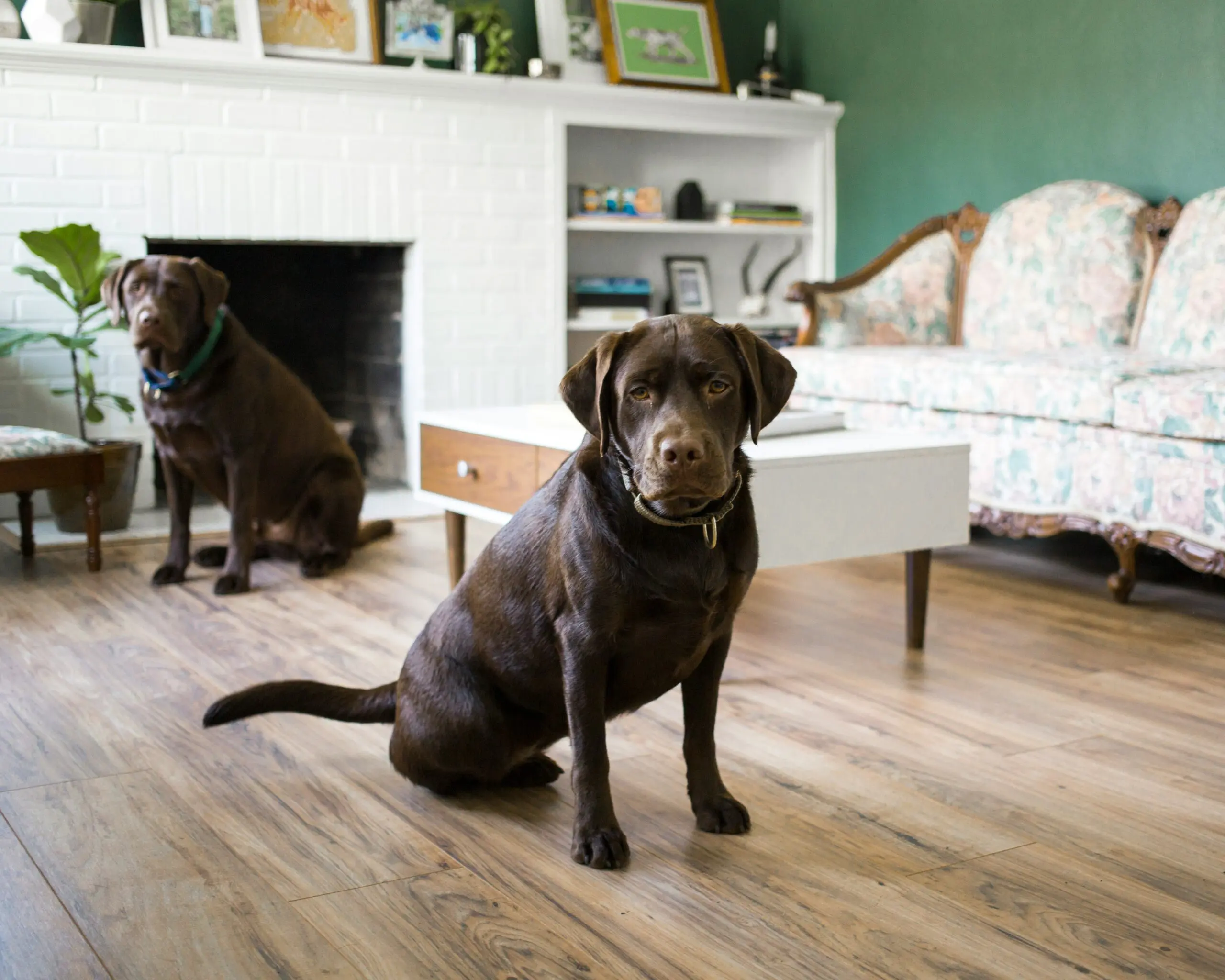Flooring is set to play an ever-more central role in interior design, combining aesthetic aspirations with performance, sustainability, and lifestyle adaptability. From Scandinavian-light palettes to intricate parquet patterns and truly pet-friendly surfaces, the trends for flooring choices in 2026 are beginning to emerge. In this article, we highlight five key trends that tradespeople, specifiers and clients should be aware of.
Trend 1: Light-Coloured Flooring

One of the strongest signals continuing into 2026 is the dominance of light-toned floors. Whether bleached oak, pale natural finishes or subtle white-washed effects, lighter floors contribute to brighter, more expanded spaces, reflect natural light, and pair well with the pervasive trend of minimal, calm interiors.
Why it’s a trend for 2026
- With many homeowners and commercial clients seeking to maximise daylight and create open, uplifting interiors, lighter floors deliver both function and style.
- In refurbishments, light-toned flooring can visually raise ceilings and unify spaces, especially in open-plan schemes.
- Light finishes also help highlight the wood’s grain and texture, supporting the “authentic natural material” movement.
What to watch out for / specification pointers
- Ensure that the finish remains durable, as light floors can show wear, scratches and scuffs more obviously than mid-tones or dark finishes.
- Consider UV-cured or hard-wax finishes to preserve appearance.
- Maintain a good maintenance regime: keep the substrate level, control moisture, and ensure finish protection, especially in high-traffic zones.
- Match the tone of the floor with wall treatments, skirtings and furniture: a pale floor may require warmer or contrasting furniture tones to avoid looking austere or clinical.
Trend 2: Herringbone Parquet

Classic parquet patterns are having a resurgence, and among them, the classic herringbone pattern is emerging as a favourite for 2026. It bridges the gap between traditional craftsmanship and contemporary layout, offering visual interest and surface dynamism.
Why it’s a trend for 2026
- Herringbone offers a step up in sophistication compared with a straight plank layout: it becomes a feature, not just a backdrop.
- As clients become more design-aware, they seek surfaces with visual character and pattern that are not overly “busy”.
- With engineered wood products now offering parquet formats, the installation risks are reduced, and suitability across rooms has improved.
- The pattern also works particularly well in longer rooms, open-plan zones, or to demarcate spaces (hall to lounge, dining to kitchen).
Specification pointers
- Straight plank floors might dominate for simplicity and economy, but when specifying herringbone, ensure the subfloor is correctly levelled and the installation instructions are followed: mismatch or poor alignment will undermine the effect.
- Choose finishes and widths that suit the space: narrow herringbone can feel busy in large rooms; oversized chevron/herringbone may dominate smaller rooms.
- For durability and longevity, especially in high-traffic areas, ensure the wear layer and finish are robust.
- Consider boundaries: how the herringbone meets adjoining flooring types (e.g., plank boards or tile) needs thoughtful transitions.
Trend 3: Traditional Warm Oak

While pale and contemporary floors are grabbing attention, the enduring appeal of a warm oak plank should not be underestimated. For 2026, expect a balanced uptake: not overly bleached, not grey-washed, but a rich, warm oak finish that delivers timeless appeal and versatility.
Why it’s a trend for 2026
- Warm oak bridges past and future, aligning with more traditional interiors while also fitting the “natural materials” and “bringing nature in” aesthetic that remains strong.
- It delivers resilience and familiarity: many clients want an investment floor that will last and suit changing tastes over time.
- In commercial spec or high-traffic areas, warm oak offers a safe, flexible choice. It’s much less faddish than extreme trends.
- It also offers a reliable backdrop for furniture, textiles and evolving colour schemes.
Specification pointers
- Check the grading: “Select” vs “Character” oak will affect the visible knots, variation and cost.
- Ensure the finish offers the required durability for the space; for example, TSWFC offers UV-cured finishes, UV-oiled options, and band-sawn surfaces.
- Consider engineered vs solid: warm oak plank in engineered format offers improved stability, especially important over underfloor heating or in refurbishment projects.
- Look at width: wide planks are still popular, but very wide planks may show more expansion/contraction. Ask your supplier for guidance.
Trend 4: Basket-Weave Parquet

Beyond the zig-zag of herringbone, collectors and specifiers are increasingly embracing more decorative patterns, including basket-weave parquet. For 2026, basket-weave offers a distinctively refined aesthetic, suitable for feature rooms, high-end residential, heritage refurbishment and upscale hospitality.
Why it’s a trend for 2026
- As clients seek standout floors, patterns that go beyond the norm will gain traction. Basket-weave is less common than herringbone or straight plank, and therefore feels more bespoke.
- The pattern ties into the wider “artisan craft” aesthetic. Look at floors as design features rather than just surfaces.
- This works especially well in large rooms or feature zones, such as drawing attention under lighting in a hospitality scheme or creating a sense of bespoke luxury in a high-spec home.
- With engineered sub-floors and good finish technology, more complex patterns are now feasible without the risk of excessive movement or installation complexity.
Specification pointers
- Because basket-weave involves repeating squares or rectangles laid in alternating directions (imitating woven look), again precise installation and high-quality finish matter.
- Ensure the substrate is level and flat; joints need to align.
- Consider the finish: basket-weave shows more end grain and directional change, so the wear layer and finish uniformity matter.
- In terms of cost and value, basket-weave may involve more labour or custom panels – factor this into the quote.
- When mixing with other flooring zones (e.g., plank boards in adjacent rooms), consider transitions and thresholds: the pattern may require a border or feature band.
Trend 5: Pet-Friendly Flooring

In 2026 one of the strongest lifestyle-driven trends affecting flooring will be pet-friendly surfaces. With more households having pets and an increasing number of commercial hospitality projects (such as dog-friendly hotels and pet-care facilities), flooring that can withstand claws, spills, and stains while providing easy maintenance will be high on the spec list.
Why it’s a trend for 2026
- The rise in pet ownership and multi-generational households means end-users demand floors that can live with everyday life (fur, claws, paws, food spills).
- Commercial clients in hospitality, rentals, short-term lets, and pet-friendly venues are increasingly specifying durable, easy-to-clean floors that still look premium.
- Sustainability and longevity: a good pet-friendly floor reduces the need for replacement, which supports circular economy goals.
- Hybrid lifestyles (working from home, pets in the home office, high-traffic zones) place more stress on floors than ever, so performance matters.
Specification pointers
- Look for wear layers and finishes rated for high traffic and scratch resistance, especially in wood floors.
- Consider alternatives to surfaces that show marks easily: mid-tones or patterned floors may hide wear better than very pale or very dark floors (though design will dictate choice).
- If the client has pets, consider finishes with good stain resistance and hygiene (easy to clean). Also, consider engineered constructions that resist movement/fluctuation, which could loosen boards.
- In mixed use (residential + pets, or commercial pet-friendly), consider also acoustic performance, slip-resistance, and suitability for underfloor heating.
- For wood floors, ensure the surface finish accepts recoating and educate clients about maintenance, including trimming pet claws, prompt cleanup of accidents, and using mats at entrances.
Bringing the Trends Together
While each of these five trends stands alone, in practice they often combine. For example, a specifier might choose a light-toned engineered oak plank (Trend 1 + 3) for a pet-friendly home (Trend 5). Or a boutique hotel might use basket-weave parquet (Trend 4) in warm oak (Trend 3) for the lounge area, and straight plank in a lighter tone (Trend 1) in guest rooms.
For flooring trade professionals and specifiers, the key is to understand how these trends align with client needs (aesthetic + lifestyle + durability) and project context (residential / commercial / pet usage / heritage / new build). It’s also crucial to work with manufacturers who can supply the specification mix required—sustainable sourcing, robust finishes, engineered formats, pattern options and installation support.
TSWFC provides a good exemplar for this kind of offering: their full-range product tree supports light finishes, warm oak, herringbone and basket-weave patterns, and laminate or engineered materials with pet-friendly credentials. This breadth means that over the coming year, they are well positioned to serve specifiers who wish to capitalise on these emerging 2026 trends.
Practical Tips for Trade Professionals
Here are some actionable tips to help you apply these trends in your projects:
- Sample early and view on site
Ordering free samples from a supplier is crucial: viewing a pale floor in showroom light versus actual room light (often with less daylight) can lead to noticeable differences. Bring the sample to the space and view it under evening light too. - Check substrate and installation readiness
Especially for patterns (herringbone, basket-weave), ensure the sub-floor is level within tolerance, stable, and moisture controlled. Good installation avoids pattern distortion or joint issues. - Finish specification matters
Don’t just pick colour and pattern – ensure the finish is fit for purpose: UV-cured, hard-wax oil, high wear layer, good slip resistance, acoustic backing (especially in multi-storey). - Educate clients about maintenance and use
Even the best floor will benefit from correct cleaning, entry mats, prompt spill management, and in pet homes, regular grooming and claw-care. Align finish with client lifestyle. - Consider sustainability and future resale value
Floors are long-term assets. Specifying FSC-certified, PEFC, high quality engineered boards will help future resale and align with ESG requirements in commercial projects. - Use patterns and tones strategically
- For small rooms: light tones and straight planks can expand the space visually.
- For feature spaces: patterns like herringbone or basket-weave create focus and luxury.
- For high traffic or pet-friendly zones: mid-tone finishes might hide wear better than pure white or very pale; finishes must handle abuse.
- Budget vs specification clarity
More intricate patterns (basket-weave) and wider planks may increase cost (labour, waste, premium manufacture). Be clear with clients about premium nature of pattern and installation requirement.
The flooring landscape for 2026 offers exciting opportunities: palettes that lighten and expand spaces; traditional materials given new life; patterns that marry heritage and modernity; and flooring that works hard for modern lifestyles (including pets). For trade professionals, leveraging these trends requires more than simply following colour charts—it demands thoughtful specification, good supplier partnerships, and clear communication with clients about performance vs aesthetic.
By working with a manufacturer/supplier like The Solid Wood Flooring Company, which offers light-coloured flooring, herringbone parquet, warm oak planks, basket-weave parquet, and pet-friendly products (alongside full specification credentials), you are well placed to deliver on the 2026 brief.
As you plan your next project, consider which of the five trends best suits the client, the space and the lifestyle involved, and how you can combine them effectively to deliver a future-proof floor.

